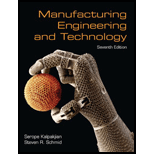
Concept explainers
What are the major properties required of cutting-tool materials? Why?
What are the major properties required of cutting-tool materials? Why?
Explanation of Solution
A cutting-tool material should have the below attributes:-
Hot hardness
Wear resistance coupled with hardness and strength of the tool stay intact at the temperatures experienced in machining operations. This property is responsible for making sure that the tool would not go through any plastic deformation. That is how it retains its sharpness and forms both.
Toughness and strength of impact
In interfered cutting tasks or forces like milling, and then turning a splined shaft on a lathe, the forces of impact on the tools is experienced time and again. This is because of vibration and chatter amid machining. But this neither chip nor break the tool.
Thermal shock resistance
To bear the fast temperature cycling, as experienced in interfered cutting.
Wear resistance
With the goal that a long-enough tool life is acquired before substituting becomes inevitable.
Chemical stability and inactiveness
Concerning the workpiece material, to evade or limit any unfavorable reactions, adhesion, and tool–chip diffusion which may fasten the wear of the tool.
Want to see more full solutions like this?
Chapter 22 Solutions
Manufacturing Engineering & Technology
Additional Engineering Textbook Solutions
INTERNATIONAL EDITION---Engineering Mechanics: Statics, 14th edition (SI unit)
Thermodynamics: An Engineering Approach
Fluid Mechanics: Fundamentals and Applications
Vector Mechanics For Engineers
Fluid Mechanics Fundamentals And Applications
Applied Fluid Mechanics (7th Edition)
- 2 2 . 16 Explain why so many different types of cutting-tool materials have been developed over the years. Why are they still being developed further?arrow_forwardDiscuss the effects of cutting speed, feed rate, and depth of cut on the tool wear rate during a turning operation. How does each parameter influence the surface finish of the workpiece? Provide a detailed explanation based on the principles of metal cutting mechanics.arrow_forward22.1 What are the major properties required of cutting-tool materials? Why?arrow_forward
- Explain the mechanics of metal cutting with neat sketch. Why machining of ductile and brittle material leads to form continuous and discontinuous chip respectively?arrow_forwardManufacturing Processes What is the effect of shear plane angle in metal cutting? Illustrate with diagramarrow_forwardWhat are the types of cutting chip? How does the built-up-edge (BUE) form, and what are the influences of BUE on metal cutting?arrow_forward
- 22.17 Which tool-material properties are suitable for interrupted cutting operations? Why?arrow_forward21.61 In Example 21.3, if the cutting speed V is doubled, will the answer be different? Explain.arrow_forward21.8 Why should we be interested in the magnitude of the thrust force in cutting?arrow_forward
- What is difference in turning and boring processes? Explain the difference if any in the equations for cutting speed, material removal rate, and machining timearrow_forwardIdentify the forces involved in a cutting operation. which of these forces contributes to the power required?arrow_forward2 1.23 Tool life can be almost infinite at low cutting speeds.Would you then recommend that all machining be done at low speeds? Explain.arrow_forward
 Elements Of ElectromagneticsMechanical EngineeringISBN:9780190698614Author:Sadiku, Matthew N. O.Publisher:Oxford University Press
Elements Of ElectromagneticsMechanical EngineeringISBN:9780190698614Author:Sadiku, Matthew N. O.Publisher:Oxford University Press Mechanics of Materials (10th Edition)Mechanical EngineeringISBN:9780134319650Author:Russell C. HibbelerPublisher:PEARSON
Mechanics of Materials (10th Edition)Mechanical EngineeringISBN:9780134319650Author:Russell C. HibbelerPublisher:PEARSON Thermodynamics: An Engineering ApproachMechanical EngineeringISBN:9781259822674Author:Yunus A. Cengel Dr., Michael A. BolesPublisher:McGraw-Hill Education
Thermodynamics: An Engineering ApproachMechanical EngineeringISBN:9781259822674Author:Yunus A. Cengel Dr., Michael A. BolesPublisher:McGraw-Hill Education Control Systems EngineeringMechanical EngineeringISBN:9781118170519Author:Norman S. NisePublisher:WILEY
Control Systems EngineeringMechanical EngineeringISBN:9781118170519Author:Norman S. NisePublisher:WILEY Mechanics of Materials (MindTap Course List)Mechanical EngineeringISBN:9781337093347Author:Barry J. Goodno, James M. GerePublisher:Cengage Learning
Mechanics of Materials (MindTap Course List)Mechanical EngineeringISBN:9781337093347Author:Barry J. Goodno, James M. GerePublisher:Cengage Learning Engineering Mechanics: StaticsMechanical EngineeringISBN:9781118807330Author:James L. Meriam, L. G. Kraige, J. N. BoltonPublisher:WILEY
Engineering Mechanics: StaticsMechanical EngineeringISBN:9781118807330Author:James L. Meriam, L. G. Kraige, J. N. BoltonPublisher:WILEY





